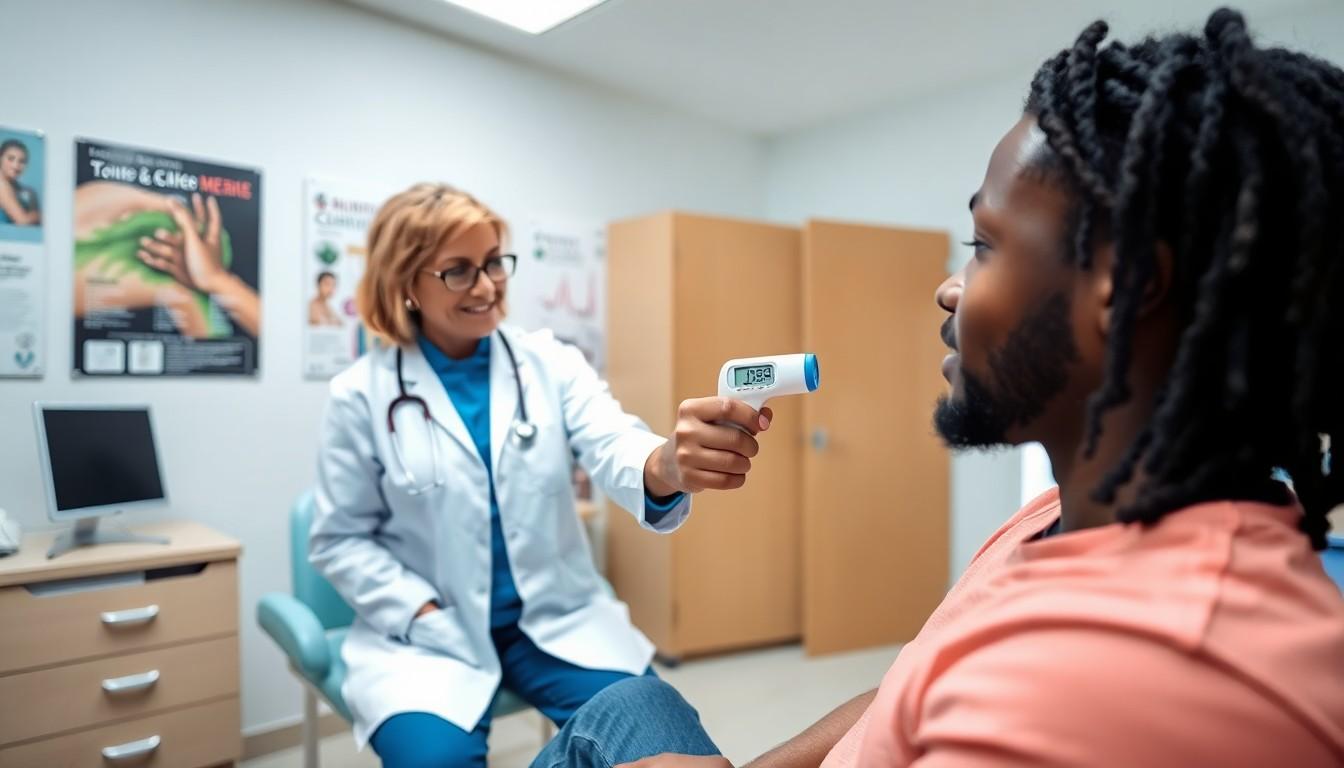Phone:
(701)814-6992
Physical address:
6296 Donnelly Plaza
Ratkeville, Bahamas.

When was the last time someone poked and prodded you in the name of health? That’s right, the physical examination is more than just a chance for doctors to show off their stethoscopes. It’s a vital step in understanding one’s health and catching those sneaky issues before they become full-blown drama queens.
In a world where self-care often means binge-watching the latest series with a side of chips, a thorough health assessment might just be the superhero you didn’t know you needed. From checking blood pressure to assessing overall wellness, these evaluations are crucial for staying ahead of potential health hiccups. So, let’s dive into why this often-overlooked ritual deserves a spot on everyone’s to-do list. After all, who wouldn’t want to know if that occasional cough is just a tickle or a call for superhero intervention?
Physical examinations serve as a fundamental component of health assessment. These evaluations facilitate early detection of health issues, allowing for timely intervention. Incorporating various techniques, these assessments enable healthcare professionals to evaluate a patient’s overall health status.
Observing physical signs through inspection, palpation, percussion, and auscultation provides crucial insights. It empowers healthcare providers to identify potential abnormalities before they develop into serious conditions. Routine health assessments encompass vital sign measurements, including blood pressure, heart rate, and temperature, which can indicate underlying issues.
Health assessments often include a comprehensive history taking. During this process, practitioners ask about medical history, lifestyle factors, and current symptoms. Gathering this information assists in developing a complete understanding of the patient’s health profile. By prioritizing these evaluations regularly, individuals gain better awareness of their health.
Utilizing modern tools and techniques enhances the accuracy of physical examinations. For instance, imaging studies and laboratory tests supplement findings from physical assessments, offering a more detailed view of a patient’s health. Engaging in regular health evaluations fosters a proactive approach to personal health management, ultimately contributing to improved long-term outcomes.
Encouraging individuals to schedule routine check-ups reinforces the importance of prevention. Individuals who prioritize their health and seek examinations regularly can better address concerns, reducing future complications. Thus, embracing physical examinations as a vital part of healthcare emphasizes awareness and early detection of potential health issues.

Physical examinations play a vital role in health management. They allow for the early identification of health issues, leading to timely intervention.
Physical examinations provide essential data for accurate diagnoses. Healthcare professionals utilize techniques like inspection and palpation. These methods help uncover hidden conditions that may not present immediate symptoms. For example, abnormal heart sounds detected during auscultation can indicate cardiovascular issues. Regular assessments make it easier to recognize changes in a patient’s health over time. Tests like measuring blood pressure and checking reflexes add crucial information to a patient’s health profile. An informed diagnosis enhances treatment options and outcomes.
Patient safety significantly benefits from routine physical examinations. Early detection of diseases diminishes the risk of severe complications. Routine assessments identify risk factors, allowing for lifestyle adjustments that promote better health. Individuals who engage in these evaluations often experience improved health outcomes. Monitoring vital signs, like heart rate and temperature, can indicate underlying conditions promptly. Furthermore, proactive health measures foster a sense of awareness and empower patients in their health journeys. Regular check-ups create a foundation for continuity in care, enhancing overall patient safety.
Health assessments consist of several critical components that aid healthcare professionals in evaluating a patient’s overall health. These components ensure a comprehensive understanding of both subjective and objective health data, as well as the necessary diagnostic tests.
Subjective data collection involves gathering information from the patient about their health experiences. Patients provide insights into symptoms, feelings, and personal health histories. This qualitative data reveals key details such as pain levels, emotional well-being, and life changes. Healthcare providers often utilize open-ended questions to encourage detailed responses. For example, asking about specific symptoms can unveil underlying issues often overlooked in a typical visit. Gathering this information allows for a more tailored care approach, enhancing patient-centered communication.
Objective data collection focuses on measurable health indicators. Healthcare professionals assess vital signs, such as blood pressure, temperature, and pulse rate. This quantifiable data yields insights into a patient’s current health state. Physical exams also include palpation and percussion methods to identify abnormalities. Diagnostic imaging adds precision, capturing images of internal body structures. Recording these observations creates a solid foundation for identifying health issues. Overall, objective data complements subjective insights, leading to a clearer health picture.
Diagnostic testing plays an essential role in health assessments. Tests such as blood work, urinalyses, and imaging studies provide crucial data for accurate diagnoses. Results from these tests can confirm or refute suspicions raised during subjective or objective data collection. Clinicians often rely on lab tests to detect conditions like diabetes or kidney disease. Imaging techniques, such as X-rays and MRIs, visualize potential structural issues. Together, these diagnostic methods enhance the thoroughness of health evaluations, guiding healthcare providers in creating effective treatment plans.
Physical examinations utilize various techniques to assess health comprehensively. These methods enhance the ability of healthcare professionals to detect potential issues effectively.
Inspection involves visually examining a patient for physical signs of health problems. This technique often starts with observing the patient’s overall appearance, including skin color, posture, and mobility. Healthcare providers frequently assess specific body areas for abnormalities, such as swelling, rashes, or deformities. Careful inspection of respiratory movements reveals conditions like pneumonia or asthma. Automated tools, such as dermatoscopes, aid in assessing skin lesions closely. Overall, effective inspection enables early identification of concerns, guiding further assessment.
Palpation entails using touch to evaluate the condition of specific body parts. By applying varying pressure, healthcare practitioners can detect abnormalities in organs and tissues. Common areas for palpation include the abdomen, where professionals check for tenderness or masses. Lymph nodes are often assessed to identify signs of infection or malignancy. With this technique, it becomes easier to gauge muscle tone and joint stability. Accurate palpation provides valuable insights, contributing to a more complete health assessment.
Auscultation focuses on listening to the body’s internal sounds, primarily using a stethoscope. This technique plays a significant role in assessing heart and lung function. By listening to heartbeats, healthcare providers can identify irregularities, such as murmurs or arrhythmias. Similarly, auscultation of lung sounds helps detect wheezing, crackles, or other indications of respiratory issues. Specific patterns may reveal conditions like heart failure or chronic obstructive pulmonary disease. Ultimately, auscultation enhances the understanding of a patient’s health status, aiding in accurate diagnosis.
Accurate documentation of findings during physical examinations is vital for effective healthcare delivery. It ensures that healthcare providers maintain a clear record of a patient’s health status. Clarity in documentation allows for easy communication among medical professionals regarding a patient’s needs.
He or she should begin by noting subjective data collected from the patient. This data includes the patient’s symptoms, health history, and any concerns raised during the assessment. Objective data follows, which encompasses measurable health indicators like vital signs, physical exam results, and testing outcomes.
Documentation should be thorough yet concise. Each finding ought to be clearly labeled, making it easy for any reader to understand without prior context. Also, including specific values, such as blood pressure readings or lab results, strengthens the documentation’s reliability.
Electronic health records have improved the quality of documentation. They streamline the data entry process while ensuring that information is easily retrievable. Medical professionals can quickly access patient histories, facilitating informed decision-making during consultations or treatments.
Regular updates are crucial for maintaining accurate records. Changes in a patient’s condition or any new findings should be documented promptly. Routine assessments conducted during follow-up appointments contribute to comprehensive tracking of health status over time.
Effective documentation of findings enhances patient care quality and supports healthcare providers in delivering accurate, appropriate interventions. By prioritizing thorough and clear documentation, professionals pave the way for better health outcomes.
Prioritizing physical examinations and health assessments is vital for maintaining overall well-being. These evaluations serve as a proactive approach to health management allowing for early detection of potential issues. By employing various techniques healthcare professionals can gather essential data that informs treatment plans and lifestyle adjustments.
Regular check-ups not only empower individuals to take charge of their health but also significantly reduce the risk of complications from undiagnosed conditions. The integration of modern tools enhances the accuracy of these assessments providing a clearer picture of one’s health status. Embracing routine evaluations ultimately leads to better long-term health outcomes and fosters a culture of prevention and awareness.